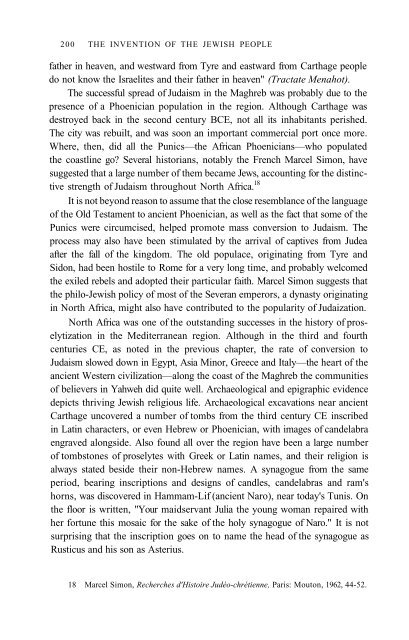Shlomo Sand, The Invention of the Jewish People - Rafapal
Shlomo Sand, The Invention of the Jewish People - Rafapal
Shlomo Sand, The Invention of the Jewish People - Rafapal
You also want an ePaper? Increase the reach of your titles
YUMPU automatically turns print PDFs into web optimized ePapers that Google loves.
200 THE INVENTION OF THE JEWISH PEOPLE<br />
fa<strong>the</strong>r in heaven, and westward from Tyre and eastward from Carthage people<br />
do not know <strong>the</strong> Israelites and <strong>the</strong>ir fa<strong>the</strong>r in heaven" (Tractate Menahot).<br />
<strong>The</strong> successful spread <strong>of</strong> Judaism in <strong>the</strong> Maghreb was probably due to <strong>the</strong><br />
presence <strong>of</strong> a Phoenician population in <strong>the</strong> region. Although Carthage was<br />
destroyed back in <strong>the</strong> second century BCE, not all its inhabitants perished.<br />
<strong>The</strong> city was rebuilt, and was soon an important commercial port once more.<br />
Where, <strong>the</strong>n, did all <strong>the</strong> Punics—<strong>the</strong> African Phoenicians—who populated<br />
<strong>the</strong> coastline go? Several historians, notably <strong>the</strong> French Marcel Simon, have<br />
suggested that a large number <strong>of</strong> <strong>the</strong>m became Jews, accounting for <strong>the</strong> distinctive<br />
strength <strong>of</strong> Judaism throughout North Africa. 18<br />
It is not beyond reason to assume that <strong>the</strong> close resemblance <strong>of</strong> <strong>the</strong> language<br />
<strong>of</strong> <strong>the</strong> Old Testament to ancient Phoenician, as well as <strong>the</strong> fact that some <strong>of</strong> <strong>the</strong><br />
Punics were circumcised, helped promote mass conversion to Judaism. <strong>The</strong><br />
process may also have been stimulated by <strong>the</strong> arrival <strong>of</strong> captives from Judea<br />
after <strong>the</strong> fall <strong>of</strong> <strong>the</strong> kingdom. <strong>The</strong> old populace, originating from Tyre and<br />
Sidon, had been hostile to Rome for a very long time, and probably welcomed<br />
<strong>the</strong> exiled rebels and adopted <strong>the</strong>ir particular faith. Marcel Simon suggests that<br />
<strong>the</strong> philo-<strong>Jewish</strong> policy <strong>of</strong> most <strong>of</strong> <strong>the</strong> Severan emperors, a dynasty originating<br />
in North Africa, might also have contributed to <strong>the</strong> popularity <strong>of</strong> Judaization.<br />
North Africa was one <strong>of</strong> <strong>the</strong> outstanding successes in <strong>the</strong> history <strong>of</strong> proselytization<br />
in <strong>the</strong> Mediterranean region. Although in <strong>the</strong> third and fourth<br />
centuries CE, as noted in <strong>the</strong> previous chapter, <strong>the</strong> rate <strong>of</strong> conversion to<br />
Judaism slowed down in Egypt, Asia Minor, Greece and Italy—<strong>the</strong> heart <strong>of</strong> <strong>the</strong><br />
ancient Western civilization—along <strong>the</strong> coast <strong>of</strong> <strong>the</strong> Maghreb <strong>the</strong> communities<br />
<strong>of</strong> believers in Yahweh did quite well. Archaeological and epigraphic evidence<br />
depicts thriving <strong>Jewish</strong> religious life. Archaeological excavations near ancient<br />
Carthage uncovered a number <strong>of</strong> tombs from <strong>the</strong> third century CE inscribed<br />
in Latin characters, or even Hebrew or Phoenician, with images <strong>of</strong> candelabra<br />
engraved alongside. Also found all over <strong>the</strong> region have been a large number<br />
<strong>of</strong> tombstones <strong>of</strong> proselytes with Greek or Latin names, and <strong>the</strong>ir religion is<br />
always stated beside <strong>the</strong>ir non-Hebrew names. A synagogue from <strong>the</strong> same<br />
period, bearing inscriptions and designs <strong>of</strong> candles, candelabras and ram's<br />
horns, was discovered in Hammam-Lif (ancient Naro), near today's Tunis. On<br />
<strong>the</strong> floor is written, "Your maidservant Julia <strong>the</strong> young woman repaired with<br />
her fortune this mosaic for <strong>the</strong> sake <strong>of</strong> <strong>the</strong> holy synagogue <strong>of</strong> Naro." It is not<br />
surprising that <strong>the</strong> inscription goes on to name <strong>the</strong> head <strong>of</strong> <strong>the</strong> synagogue as<br />
Rusticus and his son as Asterius.<br />
18 Marcel Simon, Recherches d'Histoire Judéo-chrétienne, Paris: Mouton, 1962, 44-52.




